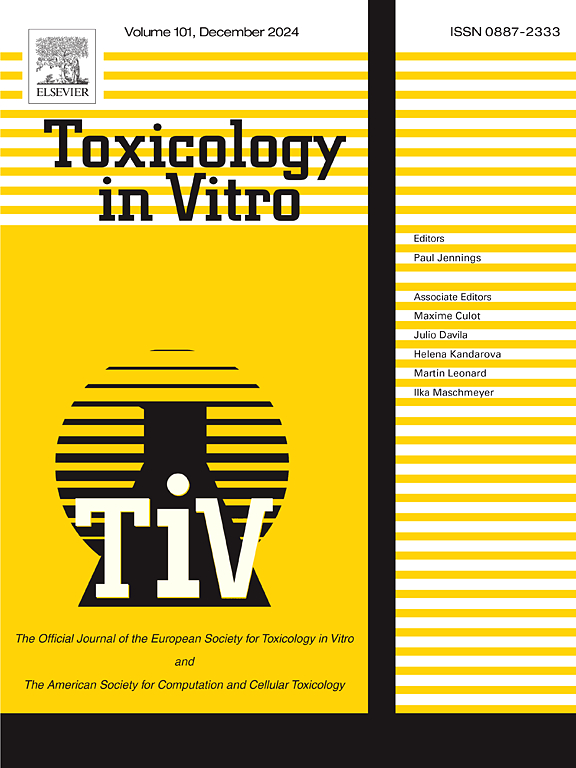Integrative toxicity assessment of tocotrienol-rich fraction from palm oil using in silico methods and zebrafish embryotoxicity model
IF 2.6
3区 医学
Q3 TOXICOLOGY
引用次数: 0
Abstract
Tocotrienol-rich fraction (TRF), a natural form of vitamin E derived from palm oil, possesses antioxidant properties. However, its potential embryonic developmental toxicity remains unclear. This study investigated TRF's toxicity using in silico methods and zebrafish embryos. Zebrafish embryos were exposed to TRF (31.25 to 2000 μg/mL) for 96 h post-fertilization (hpf). Mortality, hatching rate, heart rate, and morphological malformations were assessed at 24, 48, 72, and 96 hpf. In silico analysis predicted good pharmacokinetic properties and minimal side effects for five TRF constituents, except for hERG II inhibition, which is associated with cardiac toxicity. TRF exposure up to 96 hpf showed no embryotoxicity in zebrafish at ≤1000 μg/mL. However, TRF at concentrations of ≥1000 μg/mL significantly inhibited hatching rate at 72 hpf, indicating a delay in the hatching process. Additionally, 1000 μg/mL of TRF resulted in reduced heart rate and hypopigmentation in the embryos. Moreover, higher TRF concentrations (≥500 μg/mL) caused morphological malformations including spinal curvature, pericardial edema, and yolk sac edema, in the embryos. These findings suggest that TRF from palm oil is likely safe at concentrations below 500 μg/mL during embryonic development. However, the potential effects of long-term exposure and chronic toxicity warrant further investigation to ensure safety during early pregnancy.

利用计算机方法和斑马鱼胚胎毒性模型综合评价棕榈油中富生育三烯醇组分的毒性
富含生育三烯醇的部分(TRF)是一种从棕榈油中提取的天然形式的维生素E,具有抗氧化特性。然而,其潜在的胚胎发育毒性尚不清楚。本研究用硅片法和斑马鱼胚胎研究了TRF的毒性。将斑马鱼胚胎在受精后96 h暴露于TRF (31.25 ~ 2000 μg/mL)中。在24、48、72和96 hpf时评估死亡率、孵化率、心率和形态畸形。计算机分析预测了五种TRF成分良好的药代动力学特性和最小的副作用,除了抑制hERG II,这与心脏毒性有关。当TRF浓度达到96 hpf时,≤1000 μg/mL,斑马鱼无胚胎毒性。≥1000 μg/mL的TRF显著抑制72 hpf时的孵化率,延迟了孵化过程。此外,1000 μg/mL的TRF可导致胚胎心率降低和色素减退。较高TRF浓度(≥500 μg/mL)可引起胚胎脊柱弯曲、心包水肿、卵黄囊水肿等形态畸形。这些发现表明,在胚胎发育期间,棕榈油中的TRF浓度低于500 μg/mL可能是安全的。然而,长期接触和慢性毒性的潜在影响需要进一步研究,以确保妊娠早期的安全。
本文章由计算机程序翻译,如有差异,请以英文原文为准。
求助全文
约1分钟内获得全文
求助全文
来源期刊

Toxicology in Vitro
医学-毒理学
CiteScore
6.50
自引率
3.10%
发文量
181
审稿时长
65 days
期刊介绍:
Toxicology in Vitro publishes original research papers and reviews on the application and use of in vitro systems for assessing or predicting the toxic effects of chemicals and elucidating their mechanisms of action. These in vitro techniques include utilizing cell or tissue cultures, isolated cells, tissue slices, subcellular fractions, transgenic cell cultures, and cells from transgenic organisms, as well as in silico modelling. The Journal will focus on investigations that involve the development and validation of new in vitro methods, e.g. for prediction of toxic effects based on traditional and in silico modelling; on the use of methods in high-throughput toxicology and pharmacology; elucidation of mechanisms of toxic action; the application of genomics, transcriptomics and proteomics in toxicology, as well as on comparative studies that characterise the relationship between in vitro and in vivo findings. The Journal strongly encourages the submission of manuscripts that focus on the development of in vitro methods, their practical applications and regulatory use (e.g. in the areas of food components cosmetics, pharmaceuticals, pesticides, and industrial chemicals). Toxicology in Vitro discourages papers that record reporting on toxicological effects from materials, such as plant extracts or herbal medicines, that have not been chemically characterized.
 求助内容:
求助内容: 应助结果提醒方式:
应助结果提醒方式:


